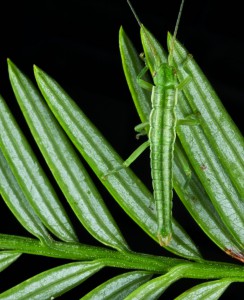 BMC Ecology talks to Dr Moritz Muschick, a postdoctoral researcher at the University of Sheffield (UK), about his winning image in the journal’s first Ecology Image Competition. You can read more about what the judges made of the image — a beautifully camouflaged stick insect resting on its host plant — in an accompanying Editorial.
BMC Ecology talks to Dr Moritz Muschick, a postdoctoral researcher at the University of Sheffield (UK), about his winning image in the journal’s first Ecology Image Competition. You can read more about what the judges made of the image — a beautifully camouflaged stick insect resting on its host plant — in an accompanying Editorial.
What is the background story to this image, and how did you come to take it?
The photo was taken on a field trip to California last year. Patrik Nosil and myself were collecting Timema stick insects for my postdoc project. To document the different species we caught and the host plants we found them on, I had brought my camera along. It was my first time to see these critters alive and in nature, I only knew them from standardized photos made to gather data from. I didn’t expect them to be so well camouflaged. That wasn’t easy to capture with a camera – they are called walking sticks for a reason – but some kept still for long enough for me to take pictures.
How did you first become interested in ecology and evolutionary biology?
Ever since I found my first fossil I wanted to become a scientist. Luckily, my family and friends were very supportive, so I did end up as one. Even the head of my school allowed me to skip some weeks so I could go on field work. I think that was what fascinated me most in the beginning, the field work involved in studying ecology and evolutionary biology, and it still is my favorite part of my job.
 What is your background as a research scientist, and what you are currently working on?
What is your background as a research scientist, and what you are currently working on?
During my university studies in Konstanz, Germany, I joined Axel Meyer’s lab, where I started to work on cichlid fishes. I stuck with cichlids for my PhD in Walter Salzburger’s lab at the University of Basel in Switzerland. Both projects were concerned with ecomorphological evolution in adaptive radiation. In my current postdoc project with Patrik Nosil in Sheffield I’m focussing on the genomic basis of adaptive radiation in Timema stick insects. I will correlate genomic divergence between different species and populations with their ecological adaptions, for example to their host plant or to the local climate.
Would you class yourself as an occasional photographer, or a keen amateur – and why?
By now I would describe myself as a keen amateur. My first camera I got as a teenager, and since then was really enthusiastic about taking pictures. Unfortunately it was rather expensive, the equipment anyway and back then also the films and the processing, so I couldn’t do as much as I wanted. With everything being digital now, the freedom to experiment is great. Trying different lighting situations or camera settings is really fun and also very productive, because you see the results immediately and can adjust things right away.
What do you think is the key to capturing a good ecological image?
It’s rather self evident, but having a camera at hand is important. That means I often take equipment with me without actually taking many pictures. In some field work situations one also risks damaging it. But I guess that’s what one has to put up with in order to take a good photo if the opportunity arises. For illustrating an ecological interaction I think reduction is helpful. To show only the most important ‘actors’. In the image here a herbivorous insect and its host on which it is very well camouflaged. Mimicry, camouflage or aposematism clearly lend themselves to such reduction.
Plans for the future?
I find ecomorphological and genomic evolution in adaptive radiations to be extremely fascinating topics and I will continue working on them. Luckily that often involves very photogenic species so I hope to expand on my photography as well.
You can also find out more about some of the other winners in the competition over on their personal blogs:
Runner-up Benjamin Blonder keep his excellent weekly ecological photoblog “Natural Curiosities” regularly updated; whilst conservation biologist-cum-artist Hara Woltz keeps a portfolio of beautiful nature-inspired artworks over on her website, which includes the winning image for the Conservation Ecology and Biodiversity category prize.
We urge you to take a look!

[…] over to the BMC-series blog to also read an accompanying interview with the overall winner, Dr Moritz Muschick of the University of […]